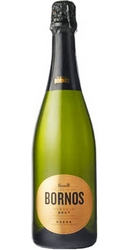Cava is Spain’s foremost sparkling wine. The vineyards of the Cava DO cover a large part of Spain’s growing land, though are concentrated in Catalunya. Recognisable brands like Arrestel Cava, Juvé y Camps Cava, and even Muga Rioja take pride of place in the Spanish sparkling wine section of wine shops throughout the world. So large is the growing area for Cava, and so ubiquitous are its brands, you’d be forgiven for thinking that “Cava” is simply a byword for Spanish sparkling wine in general.
-
Spoiler alert: It’s not!
Though its growing area is large, the production of Cava is tightly controlled and regulated. Not every Spanish sparkling wine is Cava. The Consejo Regulador del Cava oversees everything Cava-related and is strict in controlling every aspect of Cava production and labelling.
5 things you need to know about Cava:
For a Spanish sparkling wine to be labelled as “Cava”, it must adhere to a strict set of rules and regulations. The average wine lover doesn’t necessarily need to know it all, so here’s the key stuff:
- Most Cava comes from the Penedès area of Catalunya, though there are various other permitted areas that are not geographically connected. Other important areas include Rioja and Navarra.
- A considerable majority of Cava is dry, produced to at least a Brut style, if not drier again – Brut Nature Cava is increasingly popular, for example!
- The key white grape varieties for Cava are Macabeo (Rioja Blanco‘s Viura), Xarel.lo and Parellada, while rosé Cava uses Garnacha and Monastrell. In addition to these Spanish grape varieties, there are a number of international grapes permitted – notably Pinot Noir, Chardonnay and Cabernet Sauvignon.
- Cava is made using the traditional method, like Champagne and French Crémant wines.
- Conveniently, Cava prices tend to be on the modest side, particularly when compared with Champagne. This is great news for the wine lover, because you can pick up a great bottle without spending much money at all!
3 Spanish sparkling wines you probably don’t know
Shop for Cava wine, and you’ll find enough variety of tastes, flavours and styles to last you a lifetime. It’s the best-known, but Cava is not Spain’s only sparkling wine. Adventurous and inquisitive sparkling wine lovers may want to venture off the beaten track to discover some new styles of Spanish sparklers!
1. Clàssic Penedès sparkling wine
The designation Clàssic Penedès is new and exciting: Since 2014, this term refers to a select group of winemakers from the Penedès region (where lots of Cava is made) that have grouped together to make Spanish sparkling wine from the traditional method but with some extra conditions on top.
The rules state that Clàssic Penedès wines must:
- Be made from organic grapes
- Be cellared for at least 15 months before release, effectively making them Reserva wines
- Utilise exclusively the ancestral and indigenous grape varieties of the Penedès region.
A leading producer in this style of wine is AT Roca, owned by Agustí Torelló Sibill, one of the sons of the legendary winemaker Agustí
Torelló Mata. Its Brut style wine is AT Roca Brut Reserva, and we’ve opened a bottle to give you a taste of it!
Tasting AT Roca Brut Reserva 2014
Visually, this has tiny bubbles (“a fine mousse”, as they say) and a pale yellow colour
On the nose, there are enticing fruity notes, particularly of apples and pears
On the palate, it is fresh with generous acidity, and a long fruit-driven finish
Sound good? Pick up a bottle of AT Roca Brut Reserva 2014 here. Pair this with sushi or special fried rice, and see why Classic Penedès is such an exciting alternative to Cava!
2. Rueda Espumoso sparkling wine
The Rueda region is best known for its still white wines from Verdejo and Sauvignon Blanc. They are also proud of the local sparkling wine, Rueda Espumoso – and rightly so! Though without the high profile of Cava, this is a Spanish sparkler that you’ll want to try.
Quick facts about Rueda Espumoso
- It’s made in the traditional method, like Cava and Champagne
- It must be aged for at least 9 months in the bottle before release
- There are different styles with individual requirements, but each style must contain the Verdejo grape variety
One of the leading producers in Rueda is Palacio de Bornos. Its Espumoso, Palacio de Bornos Brut, is an excellent example of Rueda bubbly.
Tasting Palacio de Bornos Brut
 The colour is pale yellow, with hints of brighter green showing through.
The colour is pale yellow, with hints of brighter green showing through.
On the nose, this is hugely aromatic: 100% Verdejo wines tend to have striking aromas, and this is no exception. There are pungent aromas of tropical fruits, cut grass and citrus.
On the palate, there is a biting layer of refreshing acidity. Fresh and fruity, this is a thirst quencher with a nice tangy finish.
Sound like your kind of thing? Grab a bottle of Palacio de Bornos Brut here. This offers serious value for money, and is a worthwhile alternative to Cava or Prosecco for your next big party. It’s great on its own as an aperitif, but even better when paired with French-style fruits de la mer like oysters, prawns and sea snails.
3. Moscato de Ochoa
OK, this one isn’t so much a category of wine but rather a one-of-a-kind. From Bodegas Ochoa in Spain’s Navarra region, MdO Moscato de Ochoa is a Spanish alternative to Italian Moscato d’Asti. Here, we’ve got a low alcohol wine that is semi-sweet on the palate.
Tasting MdO Moscato de Ochoa
Visually, this one has a striking bright gold colour and a fine mousse
Aromatically, it is pleasantly floral and fruity, with notes of white flower petals and citrus fruits
On the palate, it’s fresh and semi-sweet, with nice fruit character and gently tingling bubbles
This is not for everybody, certainly. Fans of Brut Nature Cava or Grand Cru Champagne may be disappointed, but this sort of wine has a number of ideal uses.
When to try Moscato de Ochoa
- At just 5.5% alcohol content, this is closer to a beer than a sparkling wine. This makes it suitable to serve at summer lunches and garden parties.
- Its sugar content also makes it a great dessert wine. Put away the Port and Sherry and serve this Spanish sweet sparkling wine instead!
Something of a sweet tooth? You’ve got to try this! Buy a bottle or two of MdO Moscato de Ochoa here. Even better, sign up to receive our special offers here and save €5 off your first purchase!
Want to know more about sparkling wines? Download our free ebook, The Sparkling Wines Guide!
[cta_generico id=2597]




